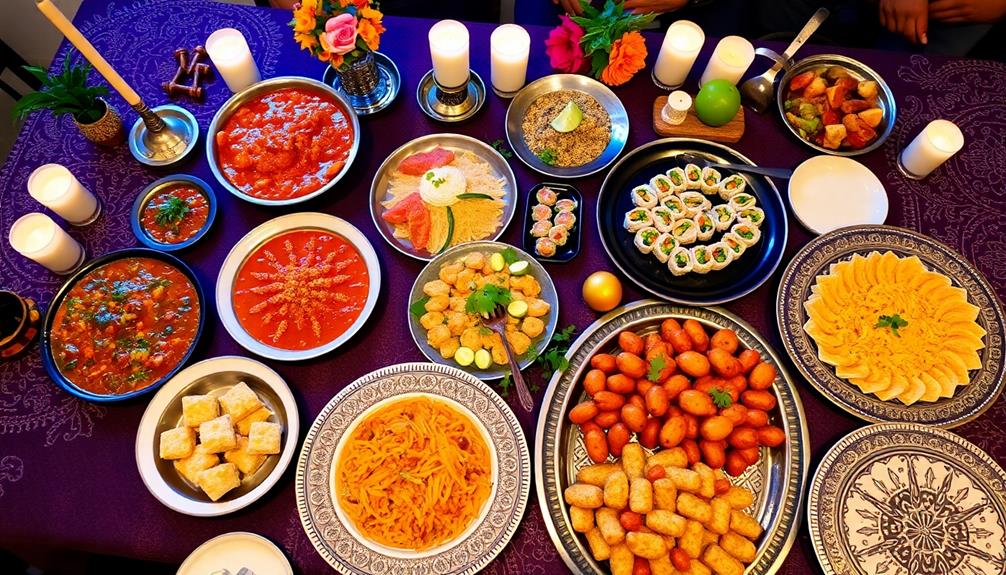Different cultures utilize food in celebratory rituals to foster strong community ties and honor their heritage. For example, meals eaten during religious holidays like Easter and Passover hold significant spiritual importance. Unique dishes, such as sweets during Diwali or turkey on Thanksgiving, represent feelings of gratitude and happiness. Dietary guidelines, such as kosher and halal, influence how communities express their beliefs through food. Sharing these meals not only strengthens social connections but also preserves cultural heritage. As you delve deeper, you will uncover even more intriguing ways food serves as a vital tool in bringing people together across different traditions.
Key Takeaways
- Food serves as a symbol of community and cultural identity, reinforcing bonds during celebrations like Thanksgiving and Diwali.
- Ritual meals, such as the Seder and Iftar, connect individuals to their faith and heritage, emphasizing shared spiritual experiences.
- Dietary laws like kosher and halal shape food practices, influencing how communities celebrate and express their cultural values.
- Symbolic foods, such as matzah in Judaism and lamb in Christianity, carry historical significance and enhance the meaning of rituals.
- Regional variations in food rituals, like ladoos for Diwali or songpyeon for Chuseok, reflect unique cultural traditions and foster community ties.
Significance of Food in Celebrations
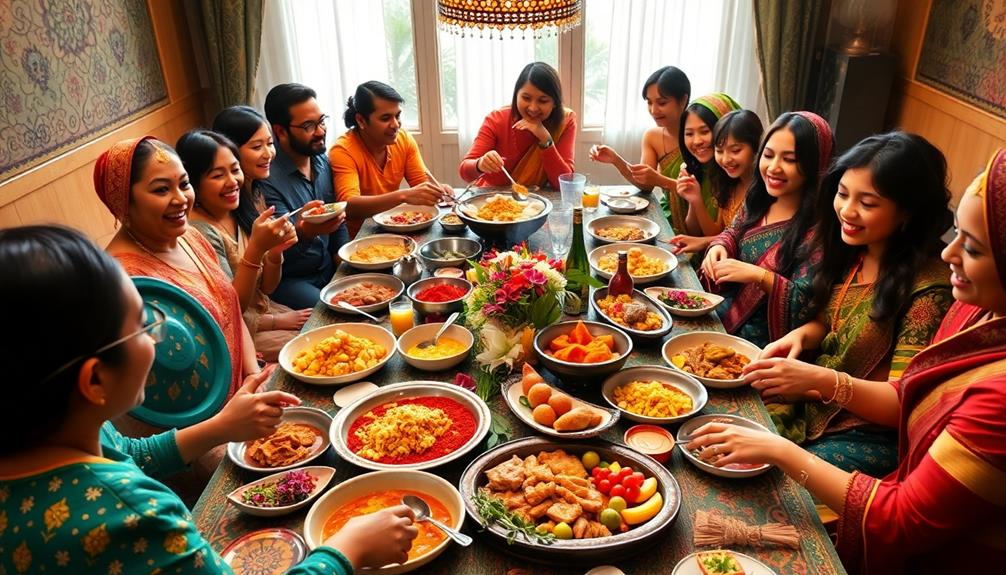
Food holds immense significance in celebrations, serving as a powerful symbol of community, heritage, and spirituality. You'll find that many food rituals are intricately tied to religious foods, enhancing the overall experience of the occasion.
For instance, during Easter and Passover, lamb and unleavened bread aren't just meals; they embody profound spiritual meanings and tell historical stories. Similarly, when you break your fast with dates during Ramadan, it's not just about the food; it's a moment of reflection and connection with others at your table.
In various cultures, like the festive Muamba De Galinha in Angola, traditional dishes are central to family gatherings and celebrations, reinforcing bonds among loved ones.
The importance of food extends beyond mere sustenance. Traditional dishes, like matzo during Passover, commemorate significant events, reminding you of your cultural identity and shared history.
Festivals like Diwali and Thanksgiving also celebrate abundance through unique culinary practices, promoting gratitude and reinforcing communal ties. These gatherings—centered around meals—serve to strengthen social relationships and highlight the rich tapestry of cultural heritage across diverse communities.
Religious Celebrations and Food Practices

In many religious celebrations, you'll find that food plays a crucial role in connecting individuals to their faith and heritage. For Christians, Easter is marked by traditional foods like lamb, bread, and colored eggs, each symbolizing the resurrection of Jesus Christ and the arrival of spring.
Jewish families celebrate Passover with a Seder meal featuring matzo, bitter herbs, and wine, emphasizing the significance of deliverance through the exodus from Egypt. Similarly, in Mexican culture, celebratory foods like Chilaquiles or Tamales often accompany festive gatherings, showcasing the importance of culinary traditions in marking special occasions.
During Ramadan, Muslims fast from dawn until sunset, culminating in Iftar meals that often include dates, lamb, and communal dishes, which celebrate the end of fasting and strengthen community bonds. These religious foods are more than just meals; they embody profound food traditions that enhance the meaning of special occasions.
Shared meals, such as the Jewish Shabbat dinner and Sikh Langar, serve as crucial mediums for expressing faith and cultural identity, fostering connections among community members.
Dietary Laws and Cultural Impact

When you explore dietary laws like kosher and halal, you discover how they shape cultural identities and practices.
These regulations not only dictate what you can eat but also influence the way communities celebrate their faith and heritage.
For instance, traditional dishes such as Kawarma (Preserved Meat) highlight the rich flavors and communal aspects of Lebanese celebrations.
Understanding these dietary practices reveals the deeper connections between food, spirituality, and cultural expression in various societies.
Kosher Dietary Practices
Kosher dietary practices, rooted in the principles of kashrut, shape not only what you eat but also how you connect with your cultural and spiritual identity. These laws dictate permissible religious foods, including which animals you can consume and how they must be slaughtered. You avoid pork and shellfish, and you don't mix meat and dairy products, which reflects a broader emphasis on dietary discipline and spiritual mindfulness.
The careful selection of ingredients mirrors the approach seen in Brazilian cuisine, where cultural influences and local practices shape the dining experience.
When preparing meals, you often use separate utensils and dishes for meat and dairy, ensuring compliance with these food customs. This attention to detail reinforces your connection to tradition and community. Many observant Jews seek kosher certification on packaged foods, contributing to a robust market for kosher products worldwide.
Food-related rituals, such as Shabbat dinners or Passover Seders, are enriched by these practices, serving as a means to strengthen community identity and cultural heritage. By adhering to kosher laws, you maintain a link to your ancestry and foster a sense of belonging, making each meal a celebration of faith and tradition.
Halal Food Regulations
Understanding dietary laws can deepen your appreciation for cultural identities, and halal food regulations serve a similar purpose within Islamic traditions. These regulations dictate what's permissible to eat and how food must be prepared, emphasizing humane treatment of animals and adherence to specific slaughter methods. Key prohibitions include pork, blood, and intoxicants like alcohol, reflecting broader Islamic principles of purity and health.
In many cultures, food plays a notable role in celebrations, much like how dishes such as Mushroom Masala offer a vegetarian-friendly option for gatherings.
Halal food isn't just about personal choices; it has a considerable impact on food production and supply chains worldwide. With a growing global market valued at over $1.9 trillion, halal certification processes are essential. Authorized personnel guarantee compliance with these dietary laws, leading to the establishment of standards in countries like Malaysia and Indonesia.
During religious rituals, halal meals are central to community gatherings, especially during celebrations like Eid al-Fitr. These occasions highlight the importance of sharing halal food, reinforcing communal bonds and cultural identity.
Cultural Reflections on Diets
Cultural dietary laws, like halal and kosher, reflect deep-rooted beliefs that shape how communities identify themselves. These dietary laws not only dictate what you can eat but also emphasize ethical consumption and humane treatment of animals.
They play an essential role in religious foods and celebrations, linking food practices to cultural identity. In Japanese cuisine, for instance, traditional dishes such as Dorayaki (Red Bean Pancake) showcase how food can be intertwined with cultural celebrations and childhood memories.
Here are three key impacts of dietary laws on culture:
- Community Identity: Adhering to specific foods fosters a sense of belonging among members of the community, reinforcing cultural ties.
- Cultural Heritage: These laws preserve traditions, ensuring that rituals and celebrations, such as Passover and Eid al-Fitr, remain authentic and meaningful.
- Ethical Consumption: By following dietary laws, you contribute to ethical practices in food preparation, reflecting values like compassion and respect for life.
The significance of these dietary laws extends beyond personal choices; they influence communal gatherings and celebrations, making the act of eating a shared, sacred experience.
Symbolic Foods Across Cultures
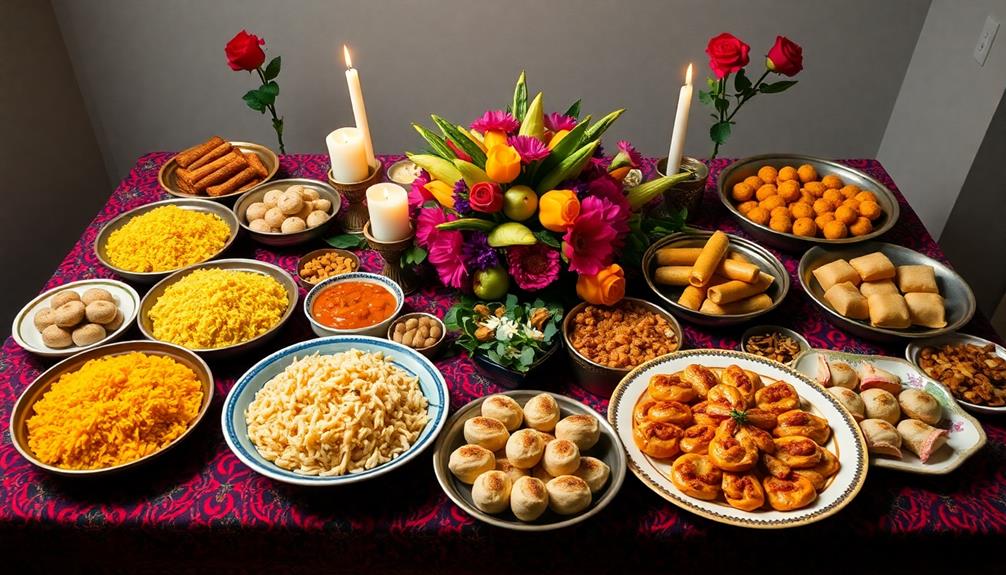
Across many cultures, food plays an essential role in celebration rituals, often carrying deep symbolic meanings. You'll find that religious foods serve not just to nourish the body but to connect you to your cultural and spiritual roots. Here's a look at some symbolic foods across different cultures:
| Culture | Symbolic Food | Significance |
|---|---|---|
| Christianity | Bread and Wine | Represents the body and blood of Jesus Christ |
| Judaism | Matzah | Symbolizes the haste of the Israelites' exodus |
| Hinduism | Sweets and Snacks | Offered as prasad, symbolizing joy and blessings |
| Christianity | Lamb | Reflects sacrifice and redemption during Easter |
| Islam | Dates | Represents hospitality and the sweetness of life |
These special rituals highlight how food can embody history, faith, and community. For example, during Passover, matzah reminds Jewish families of their freedom, while in Hindu festivals like Diwali, sweets symbolize shared joy. Understanding these symbolic foods enriches your appreciation of diverse cultural practices and their significance.
Regional Variations in Food Rituals
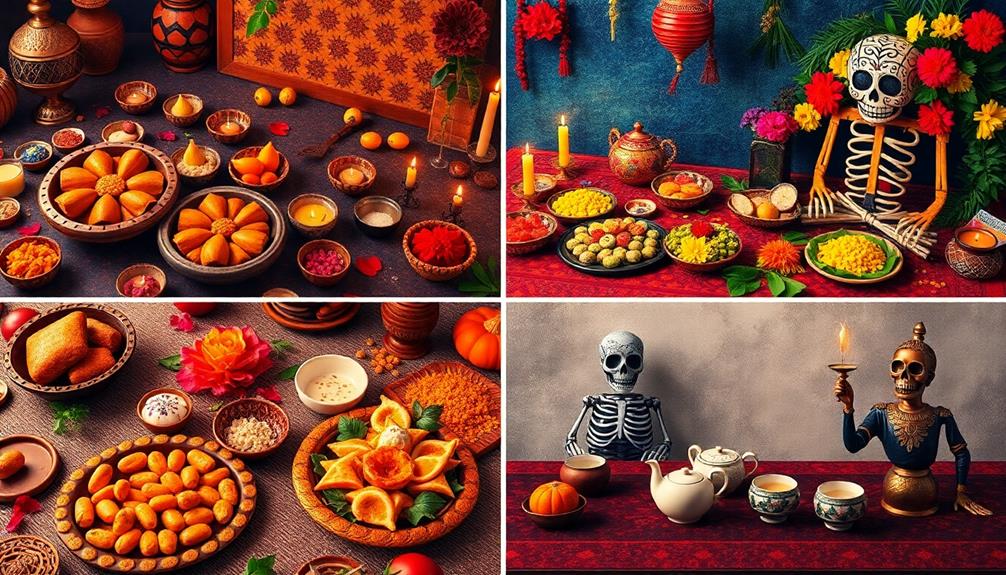
Food rituals can vary considerably across regions, each reflecting unique traditions and values. Different cultures celebrate milestones and festivals with special foods that bring people together. Here are some notable examples:
- India: During Diwali, families prepare sweets like ladoos and jalebis, symbolizing joy and prosperity. It's a time to enjoy a meal together, sharing these treats with loved ones.
- Korea: The harvest festival Chuseok features dishes like songpyeon (rice cakes) and bulgogi (marinated beef) a beloved Korean dish. These foods honor ancestors while celebrating the autumn harvest, creating a sense of gratitude.
- Sweden: Midsummer festivities focus on seasonal foods such as pickled herring, new potatoes, and strawberries. These dishes mark the summer solstice, inviting communities to enjoy a meal together in joyful celebration.
These regional variations showcase how food plays a central role in cultural rituals, allowing people to connect with their heritage and with each other.
Whether it's through the sweet treats of Diwali or the hearty dishes of Thanksgiving, these culinary traditions enrich our celebrations and strengthen our bonds.
Food as a Community Bonding Tool
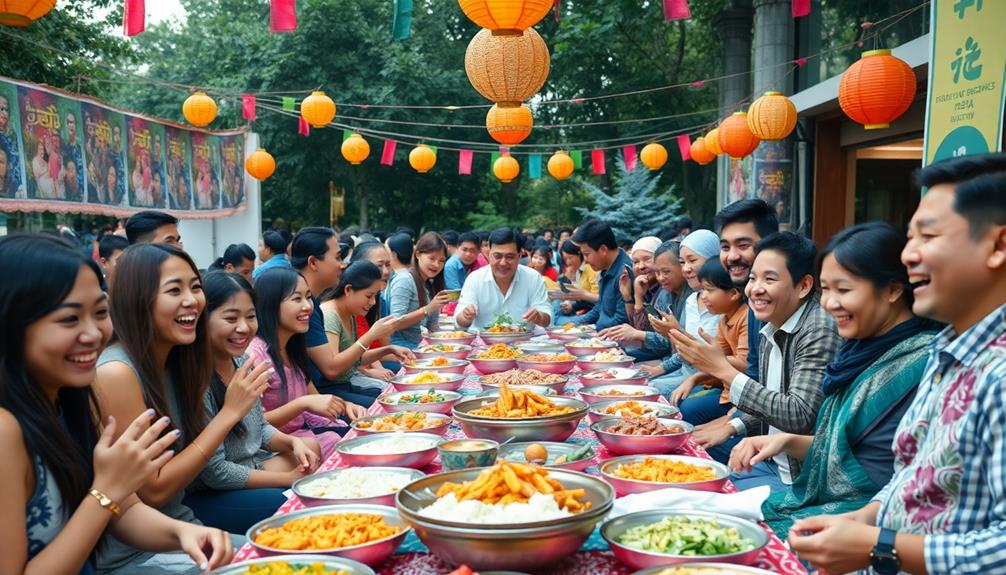
Meals shared during celebrations often become a powerful tool for community bonding, weaving together diverse individuals through the act of eating. Traditional Indonesian dishes, such as Nasi Tumpeng, symbolize gratitude and unity, creating opportunities for communal experiences that reinforce cultural identity.
Religious celebrations, like the Passover seder in Judaism and Eid al-Fitr in Islam, create opportunities for communal experiences that reinforce cultural identity. When you sit down with others to share these significant foods, you strengthen the ties that connect you to your community.
Communal meals, such as the Langar in Sikhism, emphasize equality and inclusivity, inviting people from various backgrounds to partake in a shared experience. Seasonal feasts, like Thanksgiving in the United States, allow families and communities to gather, express gratitude, and deepen social bonds.
Celebratory foods, like the sweets enjoyed during Diwali in Hinduism, symbolize joy and prosperity, actively promoting communal participation and enhancing social cohesion.
Moreover, culinary traditions and cherished recipes passed down through generations not only nourish but also reinforce familial bonds and cultural heritage. In these moments of sharing, you foster a sense of belonging and identity, ensuring that food becomes more than just sustenance; it transforms into a crucial aspect of community bonding.
Historical Context of Food Rituals
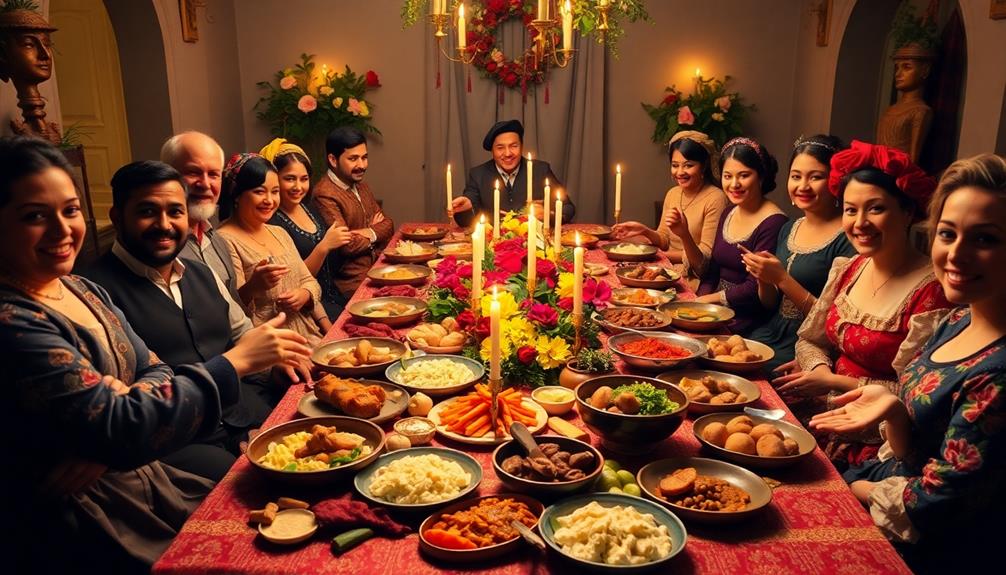
Throughout history, food rituals have emerged from significant events and seasonal changes, shaping cultural identities and communal practices.
These rituals often involve the preparation and sharing of specific dishes that carry deep symbolism, reflecting the values and traditions of a community. You can see how these rituals serve to strengthen community bonds and reflect shared beliefs.
For instance, many cultures have developed unique religious food practices that celebrate their heritage while marking important occasions, such as the way Thanksgiving traditions feature dishes like Turkey Soup made from leftover turkey, which emphasizes the value of resourcefulness and gratitude.
Here are three key examples of food rituals tied to historical contexts:
- Passover – This Jewish ritual commemorates the exodus from Egypt, using specific foods to symbolize freedom and remembrance.
- Thanksgiving – Celebrated by Native Americans and pilgrims, this harvest feast honors gratitude for the land's bounty and the community's survival.
- Kollivo – In Greek funerals, this dish symbolizes remembrance, showcasing how food connects cultural heritage to communal mourning.
Over time, dietary rules and food rituals have adapted, reflecting the interplay between cultural identity and historical events.
Middle Eastern Christian communities, for example, have developed meatless cuisines during fasting periods, reinforcing their religious observance.
These food rituals not only nourish but also embody the rich tapestry of shared values and experiences within communities.
Psychological Aspects of Eating Rituals
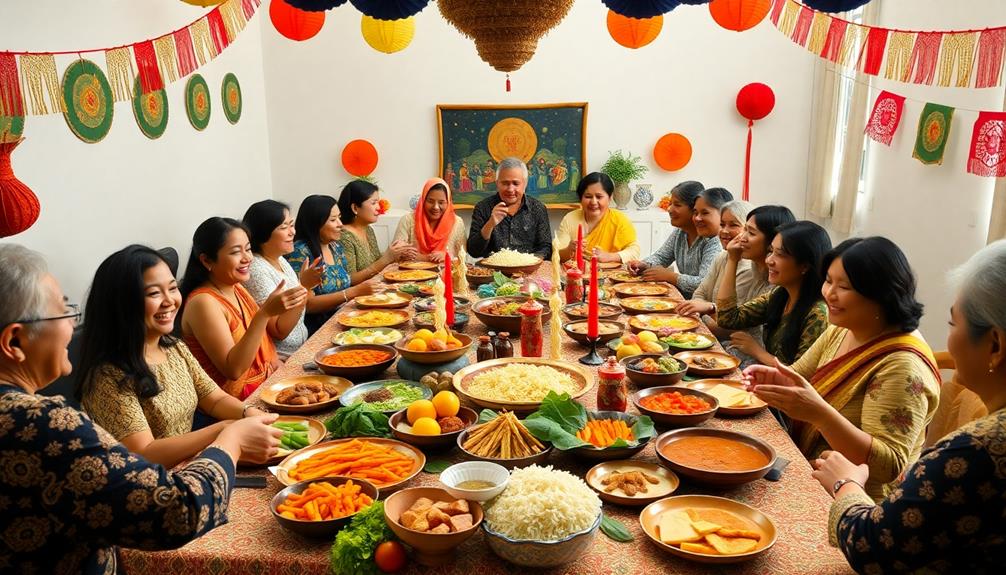
When you gather around a table for a meal, you're not just sharing food; you're building connections that strengthen your sense of community.
These shared meals often evoke powerful emotions and memories, linking you to traditions and loved ones.
For instance, many cultures celebrate special occasions with unique dishes, such as a Graveyard Taco Dip during Halloween, which adds a festive touch to gatherings.
Community Bonding Through Food
Food plays an essential role in fostering community bonds, especially during celebrations and rituals. When you gather around a table for shared meals, you're not just eating; you're engaging in a deeper connection with those around you. This act of eating collectively creates a sense of unity and belonging, allowing people to share stories, traditions, and experiences. In many parts of the world, the time of day when meals are shared is also an important cultural marker, which explains why some cultures eat late, as it allows for more time with family after the day’s work is done. This communal act of dining can transcend the food itself, emphasizing the value of togetherness and creating lasting bonds.
These food rituals create a sense of belonging and enhance social ties. Here are three key ways community bonding is reinforced through food:
- Shared Experiences: Participating in communal meals, like the Passover Seder or Ramadan Iftar, allows you to share traditions that strengthen your social bonds and reduce feelings of anxiety.
- Inclusivity: Events such as Sikhism's Langar emphasize equality, welcoming everyone to partake in meals, which reinforces shared values and community identity.
- Cultural Heritage: Sharing traditional dishes during festivals serves as a medium for storytelling, allowing you to connect with others and transmit cultural knowledge while deepening interpersonal relationships.
Emotional Connection and Memories
Celebrations centered around food not only strengthen community bonds but also evoke powerful emotional connections and cherished memories. When you gather with family and friends to share a meal, you're not just enjoying delicious dishes; you're participating in a ritual that taps into nostalgia and your cultural identity. Each bite can remind you of family traditions, allowing you to feel a sense of belonging.
The act of preparing and sharing food becomes a medium for storytelling, connecting you to your past and the experiences that shaped your identity. Think of the joy during Thanksgiving or Eid al-Fitr—these moments enhance your emotional connection with loved ones, fostering happiness and a sense of community.
Psychologically, these communal meals can even trigger the release of oxytocin, reinforcing those bonds you cherish.
Ritual foods, like unleavened bread during Passover or sweets during Diwali, carry deep meanings that evoke collective memories. As you savor these dishes, you strengthen ties not just with your immediate circle but also with a larger cultural or religious group, creating lasting memories that you'll treasure for years to come.
Symbolism in Shared Meals
During significant moments in life, shared meals take on profound symbolism that transcends mere nourishment. These gatherings often embody the essence of community bonds and cultural identity, making food rituals a pivotal aspect of various celebrations. When you partake in these meals, you're not just eating; you're engaging in a deeper connection with those around you.
Consider these key aspects of shared meals:
- Unity and Fellowship: Breaking bread, like in Christian communion, symbolizes togetherness, fostering a sense of belonging and shared faith.
- Cultural Heritage: Traditional dishes evoke nostalgia, reminding you of your family's history and enhancing emotional connections.
- Inclusivity: Practices like the Sikh Langar promote equality, ensuring that everyone shares in the experience, emphasizing our shared humanity.
In each of these food rituals, you're participating in a narrative that strengthens relationships. Whether it's a Passover seder or an Iftar meal during Ramadan, the act of sharing meals reinforces community bonds and nurtures psychological well-being.
Through these moments, you create lasting memories that enrich your sense of identity and belonging.
Practical Considerations in Food Traditions
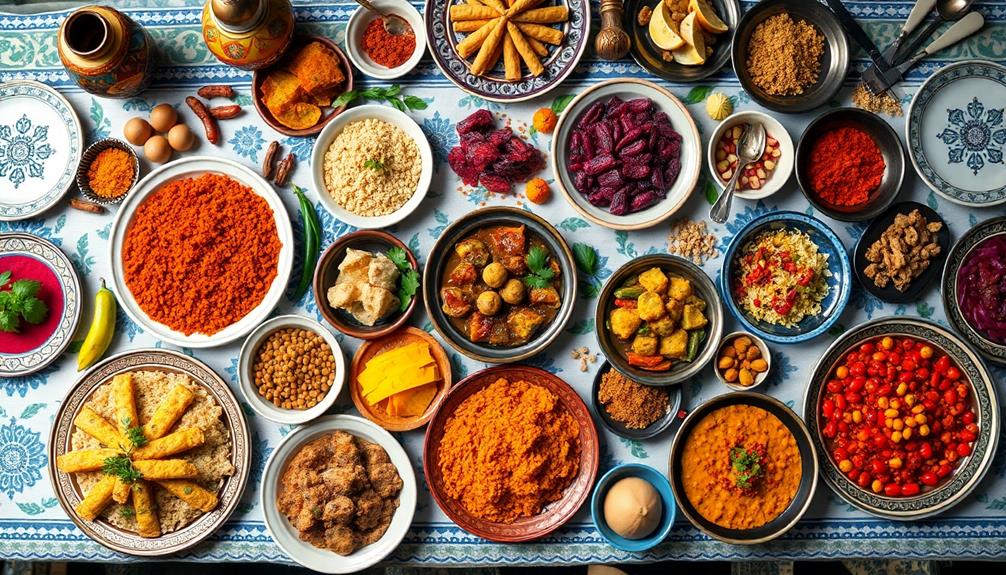
Maneuvering the intricacies of food traditions requires careful attention to various practical considerations. If you're observing dietary laws like kosher or halal, you need to be vigilant when purchasing food and drink. Always check labels and guarantee that your ingredients come from appropriate suppliers.
This level of scrutiny extends to how meals are prepared and served, as methods can affect compliance. For instance, using vegetarian stocks instead of meat-based ones can make a significant difference.
Adapting recipes is often necessary to meet specific dietary restrictions, highlighting the need for flexibility in your culinary practices during celebrations. It's not just about maintaining traditions; it's about making certain everyone can partake in the festivities.
Your daily living is often influenced by these food rituals, shaping your shopping habits and ingredient selection. Engaging in communal cooking and meal-sharing can further reinforce cultural identity, fostering connections with others.
Frequently Asked Questions
What Role Does Food Play in Celebrations?
Food's central in celebrations, creating connections and memories. It invites you to gather with loved ones, share stories, and honor traditions. Each dish often carries meaning, making the experience richer and more memorable.
What Is the Role of Food in Cultural Practices and Traditions?
Food's central in cultural practices and traditions, connecting you with history, community, and identity. It's not just nourishment; it's a way to share stories, celebrate milestones, and strengthen bonds with those around you. Certain dishes often carry historical significance, representing regions, celebrations, or even foods linked to specific jobs. For instance, shepherd’s pie was commonly eaten by shepherds in the fields, while Cornish pasties were a convenient meal for miners. These traditional foods serve as a reminder of the occupations and lifestyles that shaped various communities over time.
What Are Examples of Food Rituals?
You'll find various food rituals across cultures. For instance, breaking bread at family gatherings symbolizes unity, while sharing rice during weddings signifies prosperity. Each act brings people together, creating lasting memories through shared culinary experiences.
What Role Does Food Play in Religious Practices and Celebrations?
Food's central to religious practices and celebrations, enriching your spiritual experience. It symbolizes shared beliefs, strengthens community bonds, and marks significant occasions, creating a deeper connection between individuals and their faith through communal meals and rituals.
Conclusion
In every corner of the globe, food weaves together the fabric of celebration, transforming mere ingredients into symbols of joy and togetherness. As you gather around the table, you're not just sharing a meal; you're partaking in a rich tapestry of history and culture that binds communities. So, next time you celebrate, remember: it's not just what's on your plate, but the love and tradition behind it that truly nourishes the soul.
